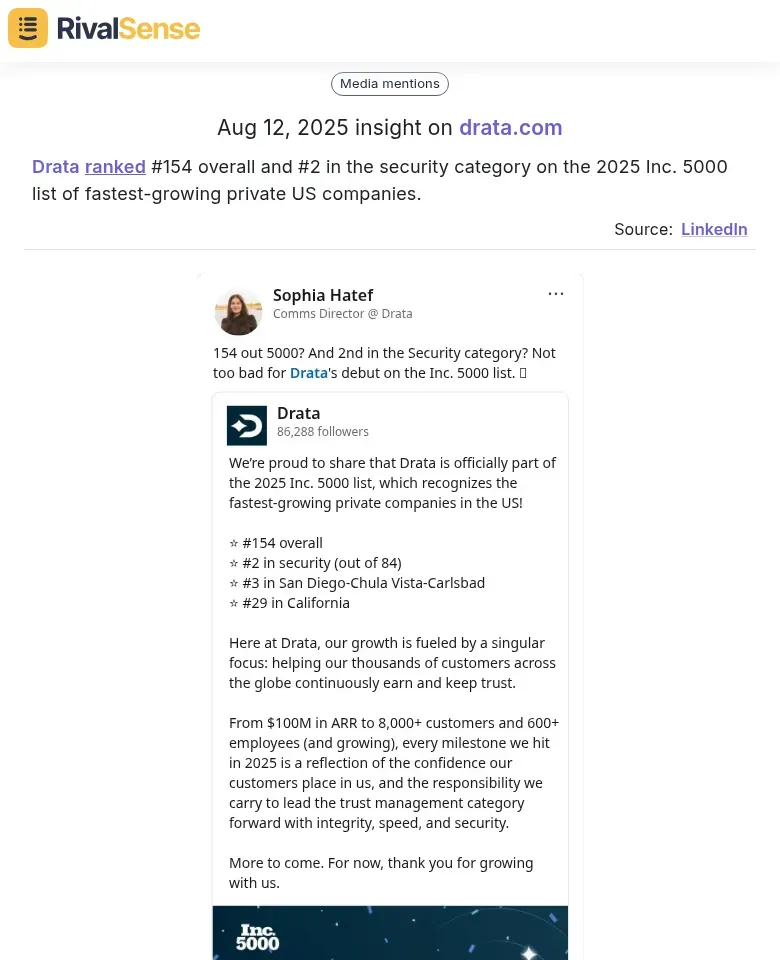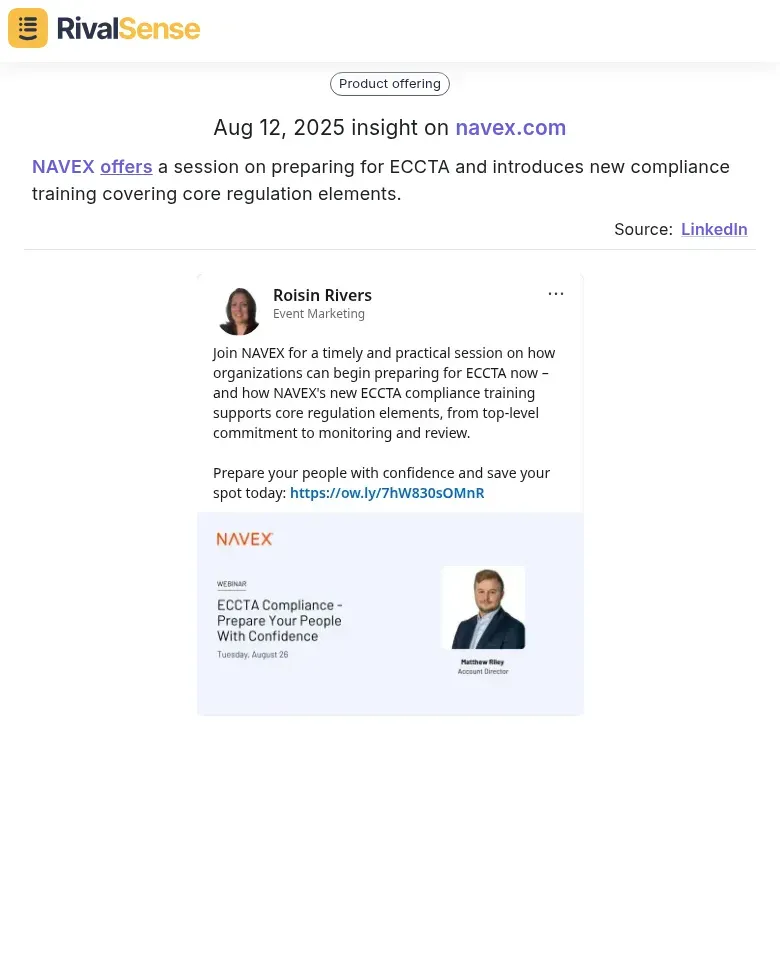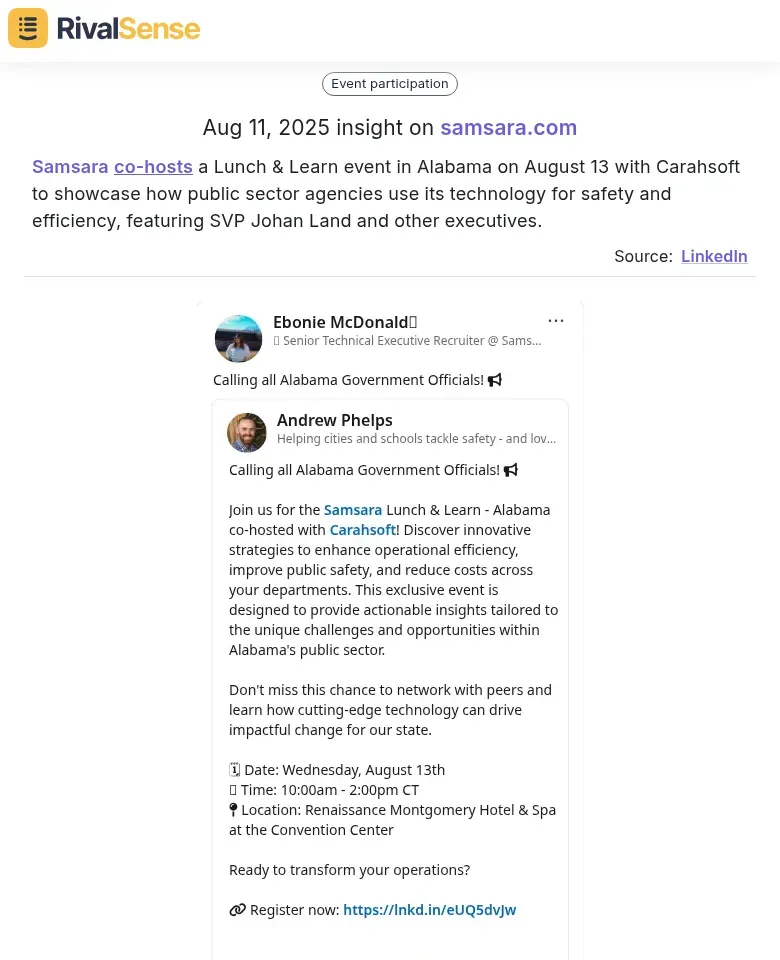Competitor Intelligence Mastery: A Practical Checklist for B2B Leaders
In today's hyper-competitive B2B landscape, monitoring competitor activities isn't optional—it's strategic survival. While LinkedIn offers valuable insights, truly comprehensive intelligence requires tracking multiple data sources. Understanding competitors' moves across rankings, content initiatives, and events provides actionable intelligence for strategic pivots and opportunity identification.
Effective competitor tracking reveals market gaps, emerging threats, and benchmark opportunities. This checklist-driven guide delivers practical frameworks to transform raw data into competitive advantage.
🏆 1. Leveraging Rankings and Recognitions
Industry rankings serve as barometers of market position and growth velocity. Monitoring these helps benchmark your performance against category leaders and reveals shifting competitive dynamics. Recognition in publications like Inc. 5000 often correlates with strategic momentum worth analyzing.
Why valuable: Rankings highlight market validation and niche dominance, enabling you to reverse-engineer growth strategies.
Practical Checklist:
- ✅ Track annual rankings in industry-specific lists
- ✅ Analyze category positioning vs. overall rankings
- ✅ Compare year-over-year ranking trajectories
Real-World Example:

Drata ranked #154 overall and #2 in security on the 2025 Inc. 5000 list—signaling exceptional growth in the compliance sector.
Action Steps:
- Create a competitor ranking dashboard
- Identify patterns among consistently top-ranked players
- Reverse-engineer their growth playbooks
📚 2. Decoding Educational Initiatives
Competitors' training programs and webinars reveal strategic priorities and market focus areas. Compliance content especially indicates regulatory readiness and target verticals. Tracking educational themes helps anticipate product roadmaps and market expansions.
Why valuable: Educational initiatives signal investment priorities and emerging capabilities before official announcements.
Practical Checklist:
- ✅ Catalog webinar topics and frequency
- ✅ Map compliance content to regulated industries
- ✅ Analyze depth of subject-matter expertise
Real-World Example:

NAVEX launched new ECCTA compliance training—indicating focus on UK regulatory markets and positioning as a governance specialist.
Action Steps:
- Subscribe to competitors' event calendars
- Analyze attendee profiles for target audiences
- Compare content depth across competitors
🤝 3. Analyzing Event Participation
Co-hosted events signal partnership strategies and geographic priorities. Speaker lineups reveal organizational expertise, while regional focus indicates market expansion plans. Event frequency and scale reflect marketing investment levels.
Why valuable: Physical and virtual events demonstrate market commitment and reveal alliance networks before formal PR.
Practical Checklist:
- ✅ Track co-hosted vs. solo events
- ✅ Note executive participation levels
- ✅ Map regional event density
Real-World Example:

Samsara co-hosted an Alabama Lunch & Learn with Carahsoft—signaling public sector focus and potential channel partnership development.
Action Steps:
- Monitor event locations for expansion patterns
- Analyze featured technologies for R&D clues
- Track partner company overlaps
🚀 Conclusion: Your Competitive Intelligence Playbook
Consistent competitor monitoring transforms market noise into actionable strategy. By systematically tracking rankings, educational content, and event patterns, you gain predictive insights for strategic decision-making. The key is institutionalizing these practices through regular reviews.
Executive Checklist:
- [ ] Weekly: Scan for ranking announcements
- [ ] Bi-weekly: Audit new educational content
- [ ] Monthly: Map event participation patterns
- [ ] Quarterly: Benchmark against findings
Implementing this framework positions you to anticipate market shifts rather than react to them. For automated competitor tracking across websites, registries, and social media—including all insights mentioned here—try RivalSense. Get your first competitor intelligence report today and turn market watching into strategic advantage.
📚 Read more
👉 How Pasažieru Vilciens Outmaneuvers Competitors: A Blueprint for Strategic Dominance
👉 Mastering Financial Competitive Intelligence: Tracking Rivals' Funding, Profits, and Ownership Moves
👉 Decoding Competitor Moves: How Aeschbach's Strategic Product Shift Impacts Your Market Position
👉 How to Track Competitor Experiments: A Step-by-Step Guide for Business Leaders
👉 Market vs Competitive Intelligence: A Dental Practice Owner's Strategic Guide
